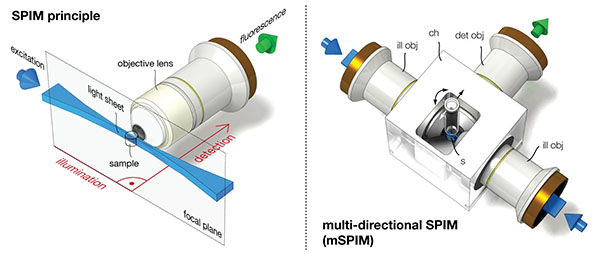Germany has a long and illustrious history in photo-optics and many of its young scientists come to the U.S., and specifically to the University of California, San Francisco, to do their doctoral and post-doc work involving microscopy. Such was the case of Dr. Jan Huisken, who developed mSPIM technology while working in the UCSF biochemistry lab of Dr. Didier Stainier as a post-doc from 2005-2009.
Multidirectional Selective Plane Illumination Microscopy (mSPIM) is an advanced illumination technique combining single-molecule spectroscopy and light-sheet fluorescence microscopy, which permits the live imaging of fluorophore labeled specimens. Specimens can be imaged for days with the advantages of low photo-toxicity and high-speed multiview acquisition
International optics leader Carl Zeiss Inc. recently licensed the mSPIM microscopy technology from the University of California, San Francisco, allowing the company the rights to integrate the new technology into its microscopy systems. The first commercial light-sheet fluorescence microscope (LSFM, also known as “selective plane illumination microscope” or “SPIM”) for multidimensional, ultrafast and long-term timelapse imaging of live specimens is currently being developed by the company in Germany.
The mSPIM technology reduces absorption and the scattering artifacts and provides an evenly-illuminated focal plane. By alternating illumination of the sample from multiple sides, mSPIM overcomes two common problems in light-sheet imaging techniques: shadowing effects in the excitation path and spreading of the light sheet by scattering in the sample.
(Image courtesy of the Huisken Lab, Max Plank Institute)
The 8-second video below, showing SPIM imaging of a 7 dpf zebrafish heart (with the endocardium in green and blood in red) was produced by Huisken in the Stainier Lab and is one of a series of fascinating micro-videos the UCSF lab has posted on YouTube:
(Video courtesy of Stainier Lab, UCSF Biochemistry)
In 2010, Huisken returned to Germany to start his own lab at the Max Planck Institute of Molecular Cell Biology and Genetics. The Huisken Lab works on organ morphogenesis and function in zebrafish that UCSF researchers and other former Stainier Lab members are actively studying.
The licensing of mSPIM microscopy technology by Zeiss represents another leap forward in 3-D microscopy of living specimens in developmental biology, cell biology, neurobiology, stem cell research and marine biology, among other fields.
If you are a life science researcher or laboratory supplier in the San Francisco Bay Area, plan on attending Biotechnology Calendar, Inc.'s next San Francisco Biotechnology Vendor Showcase™ Event. This life science laboratory product show and research networking event in San Francisco is held twice-annually: once a year on the UCSF Mission Bay campus, and one a year on the UCSF Parnassus campus. These well-attended expositions are an excellent opportunity to meet and exchange ideas with life science and medical science researchers and to learn about up-to-date laboratory products, scientific supplies and analytical equipment.
The next San Francisco Research community event will be held on January 26, 2012 at the UCSF Mission Bay Campus (where the Biochemistry Labs are also located). For show information click the button below:



